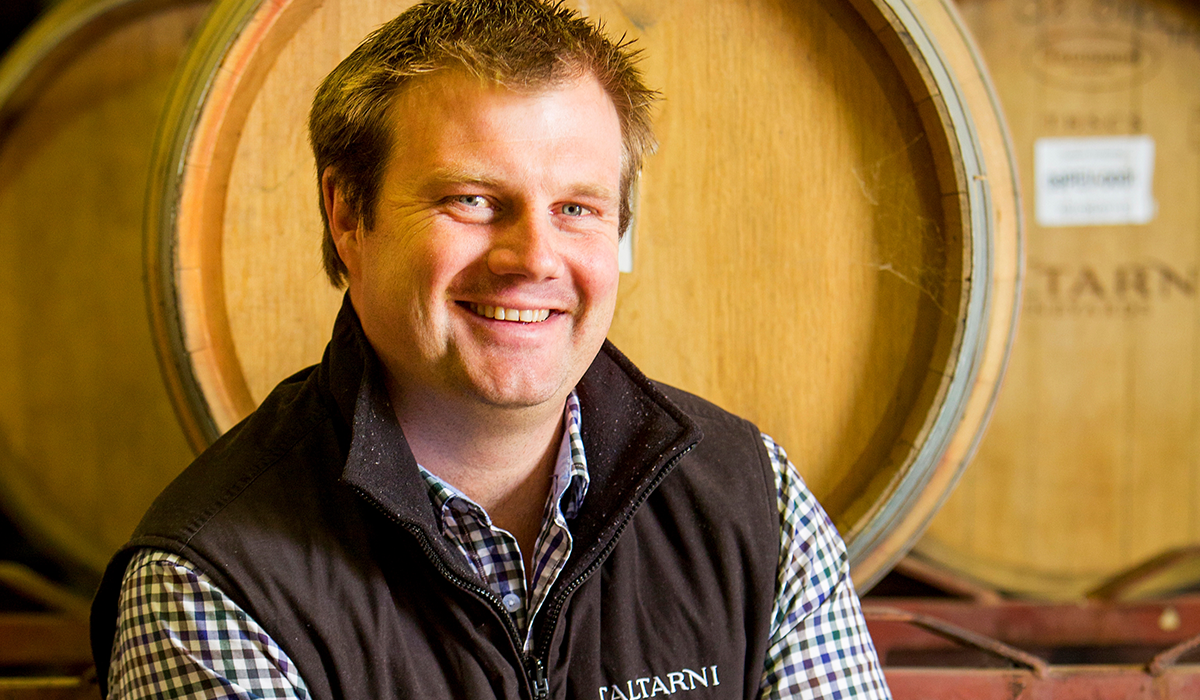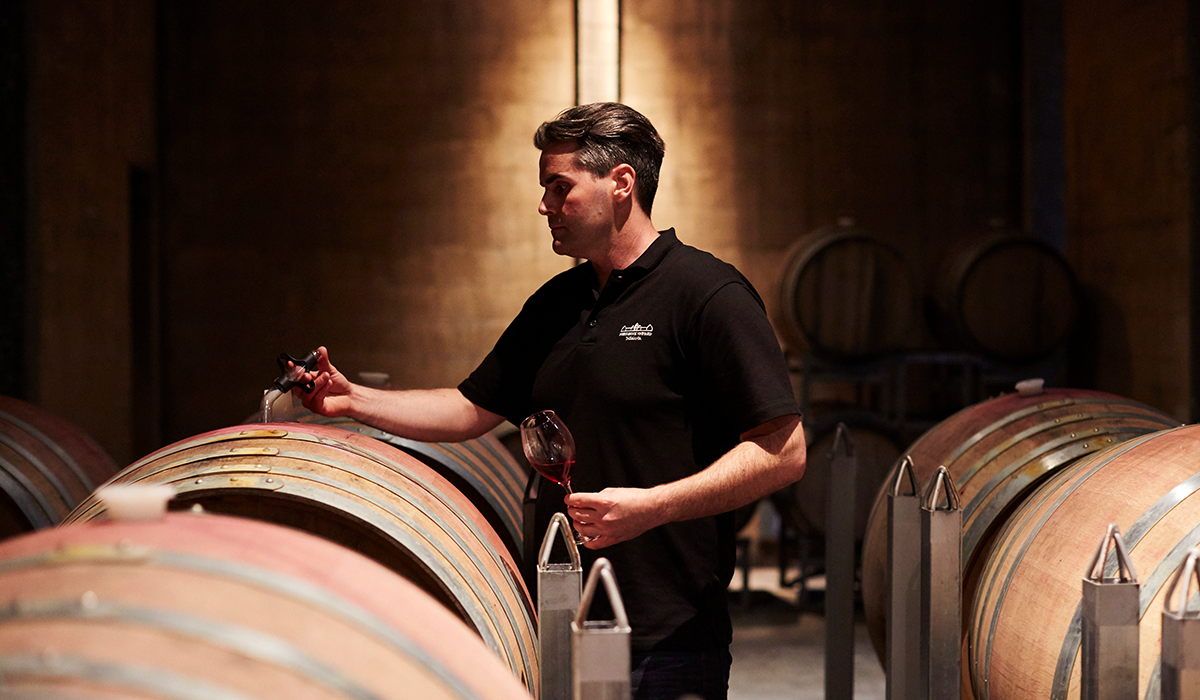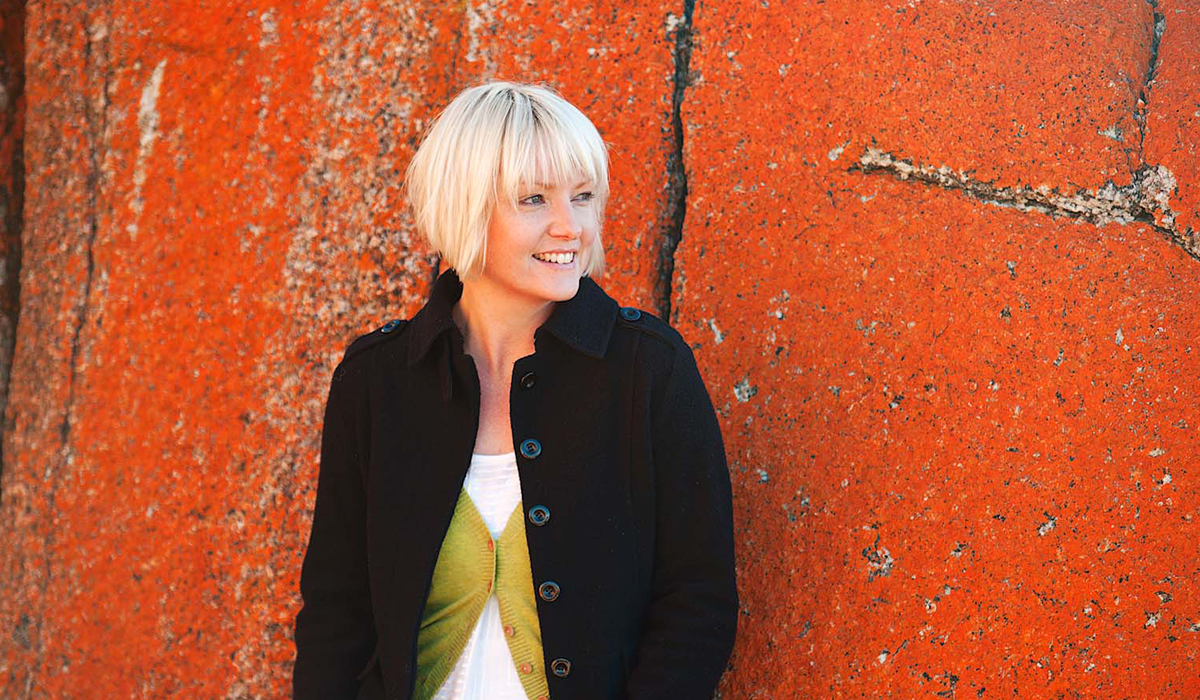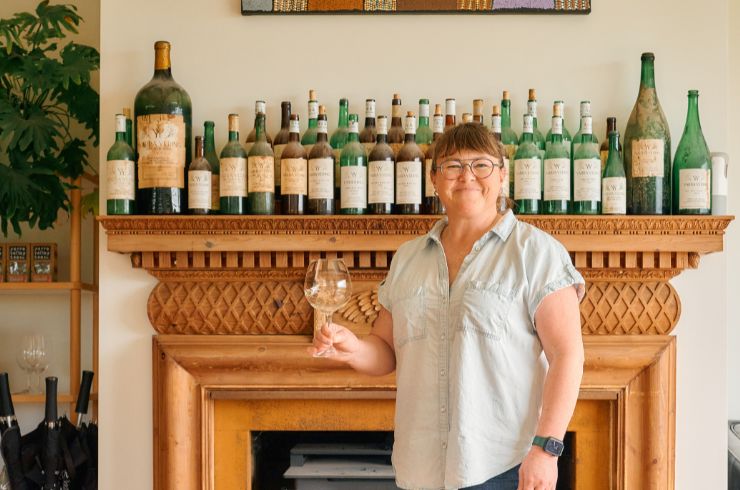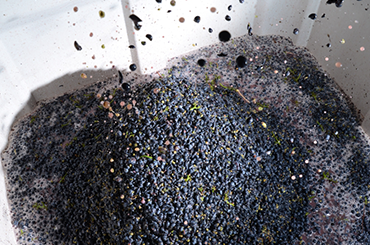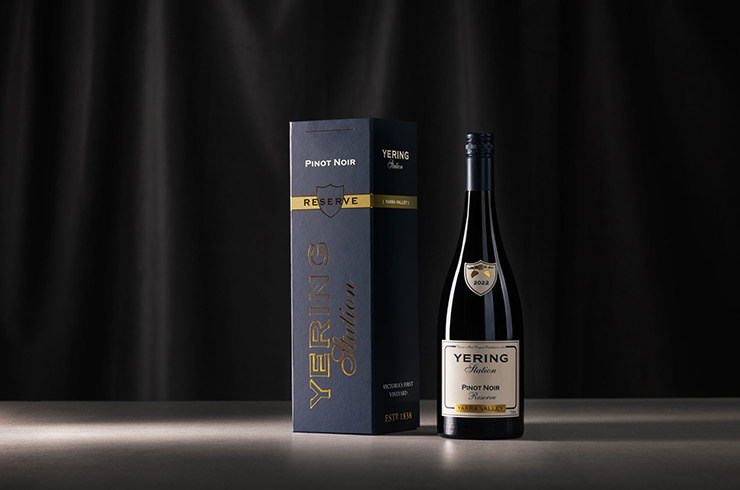"Pinot noir is made in the vineyard," says Robert Heywood from Taltarni in Victoria's Pyrenees wine region. It's a message echoed by each of the winemakers below – Greg Jarrett from St Hubert's, Luke Whittle from Pipers Brook, Rohan Smith and Peter Dillon from Handpicked Wines, Stewart Byrne from Eddystone Point and Penny Jones from Bay of Fires.
Pinot noir is one of the world's most popular grapes. It has elegance and power, however there's nowhere to hide with the variety. We spoke to six producers who have mastered making pinot noir.
Robert Heywood – Taltarni, Pyrenees VIC
H. What can you tell us about the style of pinot noir you produce?RH. Our Taltarni Pinot Noir is fruitful, soft and plush with oak that sits underneath the primary fruit and structure of the pinot noir varietal. It's designed to be an approachable and very easy-drinking style that shows the essence of our cool-climate vineyard.
This range of wines is about the evolution of the style to follow the needs and wants of the consumer. We're always looking for feedback on this wine to continue to improve the drinking experience.
H. How do you approach the winemaking process for pinot noir?
RH. For us, it’s a minimalistic approach. We use portions of whole bunches and ferment at cooler temperatures. These processes enable us to extract what is most desirable about the variety – its subtle red berry fruit and delicate structure along with crunchy acidity.
Pinot is made in the vineyard; we're intent on producing the best fruit for the wine. This involves careful canopy and fruit load manipulation during the growing season to optimise concentration and fruit purity prior to coming into the winery.
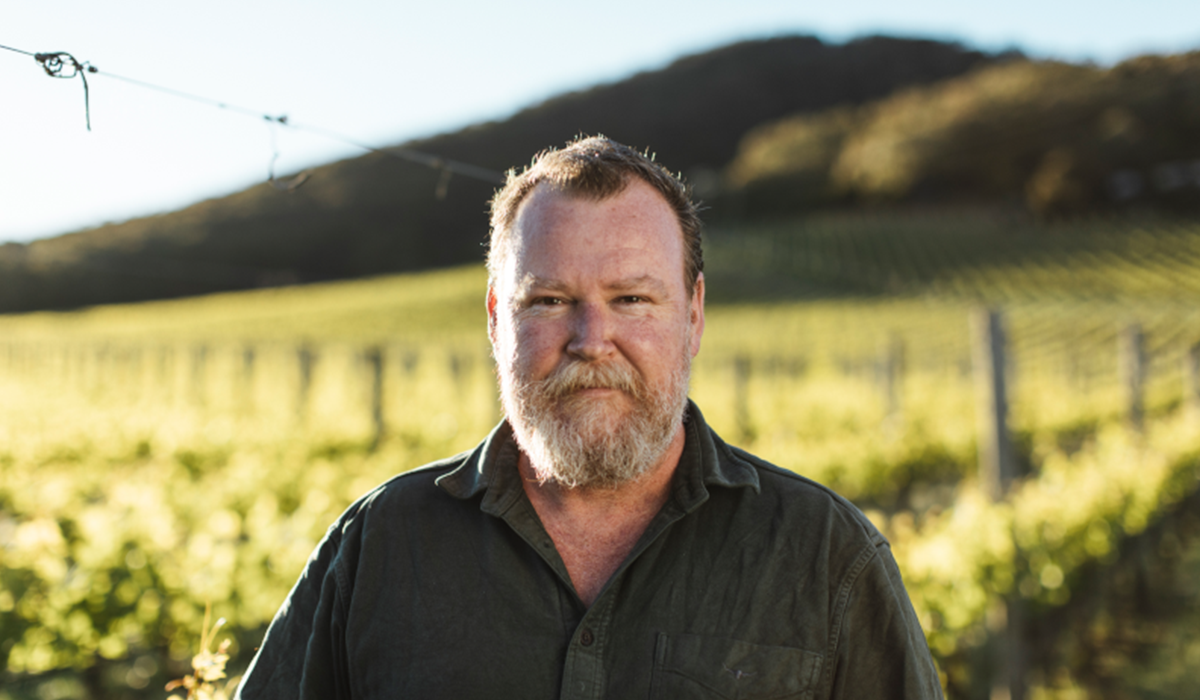
Greg Jarratt – St Hubert's, Yarra Valley VIC
H. What can you tell us about the style of pinot noir you produce?GJ. Our grapes are sourced from the Valley floor, which is generally one of the warmer and drier areas of the Yarra. As a result, our style is often riper, richer, and rounder than many of our local brethren. The wines have the lovely perfume of Yarra pinot, but expect more dark cherries than lighter red fruits.
We try and maintain a house style, but without doubt the wines will speak of the vintage conditions. St Hubert’s has typically weighed quite heavily on the 114 and 115 clones, along with the more widely planted MV6. There is a lot of redevelopment in progress in the Yarra, so the future is bright with exciting new clones to look forward to.
H. How do you approach the winemaking process for pinot noir?
GJ. Getting things right in the vineyard is true for all varieties, but perhaps never more so than for pinot. The growing bit I’m sure is harder than the making bit, so hats off to our viticulture team! Our wines are made in small and individual batches, and we try to keep things simple and gentle to reflect the site and preserve the fruit.
Making a good pinot is a bit like cutting a diamond – best to have a think about it and be open-minded to changes along the way. Experience is useful, mistakes can be costly, but the finished results can be stunning.
Luke Whittle – Pipers Brook, Tasmania
H. What can you tell us about the style of pinot noir you produce?LW. Grown in the Pipers Brook and Tamar Valley regions of the North East of Tasmania, our pinot noir is heavily influenced by the cool maritime climate that shapes our pioneering sites. This gives us elegant and expressive pinot noir, perfumed with intense aromatics, wonderful texture and fine supple structure.
Our winemaking style has definitely evolved over the years, albeit recent vintages have only seen subtle changes as we adapt to new learnings from each growing season. The biggest changes we see are distinctive hallmarks the different growing seasons leave on the wine, which in Tasmania’s cooler climate can be quite pronounced.
H. How do you approach the winemaking process for pinot noir?
LW. Our winemaking process is quite traditional. We focus on achieving the best expression of our unique vineyard sites, which often sees us adapt our approach to the site or parcels of fruit at hand. As pinot noir is a very elegant wine, it requires a gentle touch and a lot of attention to detail. I love texture in pinot noir, so we pay attention to achieving the right structure, and age the wine on lees in barrel to help build mid-palate.
Pinot noir, like all great wines, starts in the vineyard and growing wine in Tasmania can certainly have its challenges. Each vintage presents its own new set of challenges. The only thing we know for sure is that we don’t know what the next vintage will bring, which certainly keeps us on our toes and we have to keep adapting to those changing conditions.

Peter Dillon and Rohan Smith – Handpicked Wines, Mornington Peninsula VIC
H. What can you tell us about the style of pinot noir you produce?PD & RS. Pinot noir is a complex and mysterious varietal, both low yielding and particularly qualitative, and we harness this at Handpicked Wines in what we hope is an ultimate expression of the fruit. The 'fussy' grape has adapted to terroir beyond the French borders, thriving in some of the coolest climates here in Australia and resulting in wines of exceptional aromatic finesse.
Pinot noir has a reputation as one of the hardest grapes to grow, and when combined with the highs and lows that are intrinsic to each growing season it can become quite a challenge. The perseverance of our viticulture team throughout the season, along with an excellent quality of fruit at harvest, resulted in a wine that allows us to express the uniqueness of Mornington Peninsula. Growing pinot noir requires particular attention in the vineyard – and we love a challenge!
We are humbled and proud to have earned a reputation as a top cool-climate pinot noir producer. We aim to convey a sense of place through our interpretations of pinot noir from different regions, whether it's from our home vineyard on the Mornington Peninsula, or our other flagship vineyards in the Yarra Valley and Tasmania (the new mecca for cool-climate winemaking).
H. Why do you think there is such a high demand for pinot noir?
PD & RS. Although pinot noir is not new to Australian wine lovers, with Burgundian labels being available for several decades, we have seen it find great fandom in recent years. Pinot noir cuts through heavier reds and enchants drinkers with its great finesse, elegance, and subtlety. We have also seen an increase in demand from international markets that are eager for the elegance that results from cool-climate regions.
Stewart Byrne – Eddystone Point, Tasmania
H. What can you tell us about the style of pinot noir you produce?SB. Although Tasmania is one GI, we blend from across the subregions of Tasmania to utilise the strengths of their characteristics. We get our fine tannin backbone and weight from the Coal Valley and East Coast, and incorporate Derwent Valley and Pipers River fruit for aromatics and spice. Whole bunch and quality oak play an important supporting hand.
When we started in Tasmania in the late 1990s, the focus was on sparkling, and we predominantly planted clones more suited to sparkling production. The pinot noir plantings specific to table wines are now reaching maturity and provide a greater tannin and flavour structure to work with. The other maturing has come from us as winemakers – learning not to be seen goes against your natural inclinations, but we have to remember that we are not the hero here.
H. How do you approach the winemaking process for pinot noir?
SB. We like to ferment and mature all our individual blocks and clones separately. Everything is wild fermented in small batches. We don’t use must pumps, preferring gravity. We perform no plunging until very late in the fermentation, and we basket press all batches relatively early. We are attempting to minimise seed tannin while drawing out the characteristic concentrated flavours from the fruit.
The major viticultural challenge is being prepared for any eventuality the environment will throw at you. We have decided the best approach is to diversify the location of our vineyards around the state to minimise the risk of losing an entire vintage to smoke damage or flash flooding. This allows us to diversify risk and produce consistent high-quality wines.
Penny Jones – Bay of Fires, Tasmania
H. What can you tell us about the style of pinot noir you produce?PJ. We believe pinot noir should be silky, perfumed, elegant, and driven by freshness and complexity. You can expect ripe fruit, purity and power but with defined structure that supports those bright fruit flavours. The structure is built with concentrated fruit, a little whole bunch inclusion and careful oak selection.
Bay of Fires very much focuses on our house style which continues to be honed as our original plantings mature and we better understand which clones work best in each subregion. We are excited about new clonal plantings in evolving regions and believe their inclusion will only increase the complexity and quality of our wines as the vintages progress.
H. How do you approach the winemaking process for pinot noir?
PJ. For us, complexity is key. We achieve our trademark complexity by sourcing fruit from all over Tasmania, as each region produces remarkably different styles of pinot. We handle the fruit gently throughout the entire winemaking process to ensure the fruit takes centre stage. We aim for concentration, brightness and power in our wines, driven by a backbone of elegance and finesse.
When it comes to pinot noir challenges; frost, rain, wet and windy flowering weather can lead to poor set and low crops, along with waterlogging, hail, possums, wallabies, wombats, birds, mildew, botrytis, limited labour force, the Bass Strait – the list goes on! I guess it’s overcoming all the challenges which makes the successes so rewarding.
Image credit: Wine Australia.
Latest Articles
-
News
Yarra Yering has released its 2023 flagship wines – marking winemaker Sarah Crowe’s 10th vintage
17 Apr 2025 -
Wine Lists
Four 'recommended' wines to try
16 Apr 2025 -
Travel
Where to eat, drink and stay when travelling around the Murray Darling wine region
16 Apr 2025 -
Travel
Three unique restaurants to book a table at this Easter – each located within a Victorian wine region
11 Apr 2025
